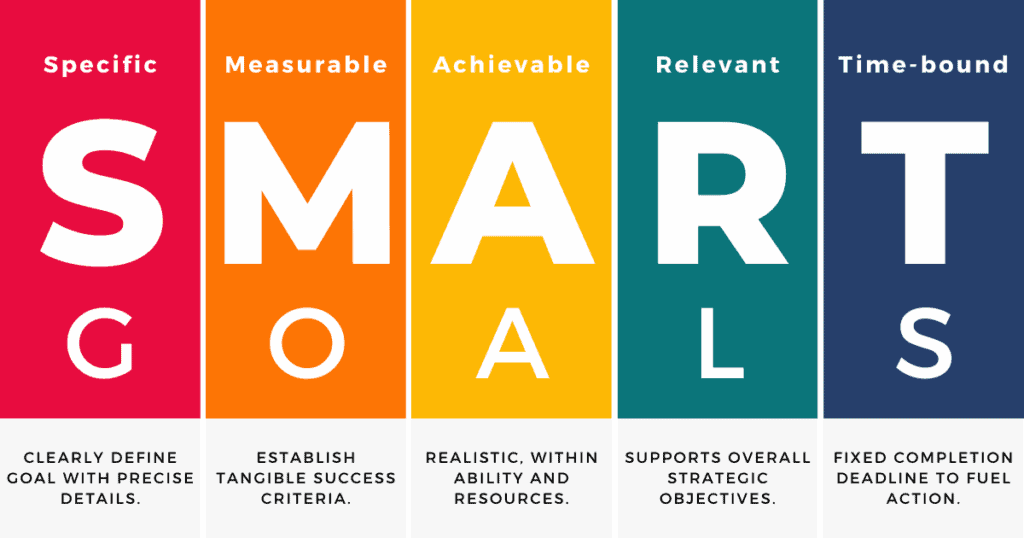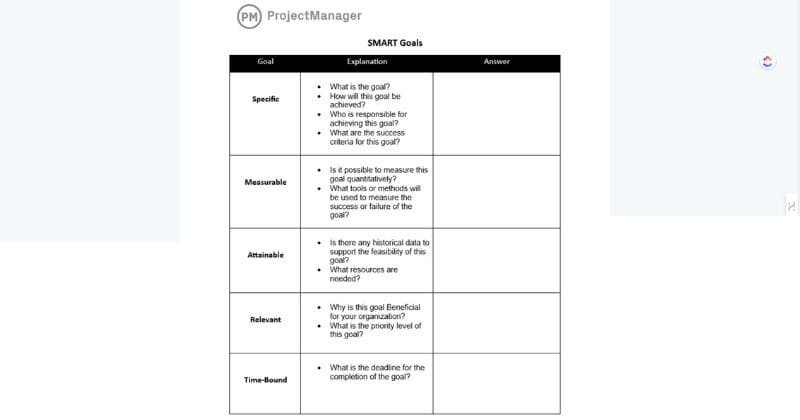Smart goals transform vague ideas into clear targets. They’re like a roadmap, guiding you to your goals with precision. For marketers, this approach is invaluable for turning ambitions into realities.
In digital marketing, I’ve applied smart goals extensively. The challenge is often in specifying goals that are measurable and achievable. My experience offers real solutions to these common challenges, making your goals more attainable.
Understanding smart goals is vital for success. It brings clarity and focus, which is especially important for impactful marketers. Next, we’ll dive into practical steps to effectively apply smart goals in your growth strategy.
What are SMART Goals?

SMART Goals, an acronym for Specific, Measurable, Achievable, Relevant, and Time-bound, are a framework used in various fields, including business, marketing, and SEO. These goals are designed to ensure clarity and effectiveness in goal setting.
Specificity defines clear objectives, measurability quantifies progress, achievability sets realistic targets, relevance aligns goals with larger objectives, and time-boundness establishes deadlines. SMART Goals are pivotal in driving successful SEO strategies, offering a precise roadmap for optimization efforts.
| Letter | Common | Alternative |
|---|---|---|
| S | Specific | Strategic and specific |
| M | Measurable | Motivating |
| A | Achievable | Attainable, Agreed, Action-oriented |
| R | Realistic | Resourced, Reasonable, Realistic and resourced, Results-based |
| T | Time-bound | Trackable, Time-based, Time-oriented, Time-limited, Time/cost limited, Timely, Time-sensitive, Timeframe, Testable |
Goal-Setting Basics
Master the fundamental principles of Smart Goal-setting and unlock the key to achieving your objectives precisely. These basics provide a solid foundation for effective goal planning, ensuring your efforts yield tangible results.
- Specific: A goal should be clear and well-defined. Instead of saying, “I want to exercise more,” a specific goal using the smart goals template would be, “I want to go for a 30-minute jog three times a week.” This follows the step-by-step approach of the smart goals acronym and can be applied to any project.
- Measurable: It’s important to have a way to track your progress and determine if you’re moving closer to your goal. For example, you can measure the miles run or the weight lifted to achieve a simple, measurable goal in your work.
- Achievable: Your goal should be realistic and attainable within your current circumstances and resources. Setting unrealistic goals can lead to frustration and demotivation.
- Relevant: Your goal should align with your overall objectives and values. It should be meaningful and significant to you personally.
- Time-bound: Setting a deadline for your project creates urgency and helps your team stay focused on completing the goal within a specific timeframe. This time-bound approach gives you the necessary push to complete the ups and downs of the project.
Applying these principles when setting goals increases your chances of success by making them more actionable and manageable.
Benefits of SMART Goals
Uncover the significant advantages of SMART Goals for clear, measurable success.
- They provide clarity: With specific criteria, you know exactly what needs to be accomplished.
- They enhance motivation: Having measurable milestones allows you to track progress, providing a sense of achievement.
- They improve focus: By breaking down larger goals into smaller, time-bound objectives, staying focused on what needs to be done in the present moment becomes easier.
How to Write SMART Goals

Setting goals is essential to achieving success, but ensuring these goals are well-defined and actionable is important.
This is where SMART goals come into play. SMART stands for Specific, Measurable, Achievable, Relevant, and Time-bound. Let’s explore each of these elements in more detail.
Specific
Setting specific goals is crucial for any project as they help you define a clear target or objective. By setting specific goals for your project, you can focus on a particular aspect or area that needs improvement or attention.
For example, instead of saying “increase product sales,” a specific project goal would be to “increase product sales by 10% within the next quarter.” This project specificity provides clarity and direction.
Measurable
Measurable goals allow you to track progress and determine the level of success achieved. When setting SMART goals for your project, assessing your progress and determining how much further you need to go becomes easier.
By measuring milestones along the way, you can ensure that your goals are attainable and relevant to the overall impact you want to make.
Achievable
Achievable goals are realistic and within reach. Setting specific and measurable objectives helps determine whether your goals are achievable.
Setting SMART goals that challenge you but are still attainable, given the resources available, is important.
Relevant
Relevant goals help you focus on the most important aspects of your work or project. Following the SMART goal framework is important when creating content or setting relevant objectives.
This framework helps to align what you’re doing with the needs and interests of your target audience or stakeholders. By setting specific and relevant goals, you can have a greater impact and achieve better results.
Time-bound
Time-bound refers to setting a specific deadline for your goals. Setting a smart goal creates a sense of urgency and accountability, giving you a timeframe to achieve your objectives.
Breaking down your larger goal into smaller time-bound milestones makes it easier to stay focused, motivated, and track your progress.
SMART goals pros and cons
Explore the strengths and weaknesses of SMART goals to make informed decisions in your goal-setting journey. Understanding the pros and cons empowers you to optimize your approach and achieve better outcomes.

Pros of SMART Goals
SMART goals have several advantages that make them a popular framework for goal-setting. Here are some key benefits:
- Clarity: Your SMART Goal adds structure and helps to clarify objectives by providing clear guidelines on what needs to be accomplished.
- Focus: By setting specific and measurable goals, individuals can prioritize their efforts and concentrate on the most important tasks. This prevents wasting time and resources on irrelevant or unproductive activities.
- Motivation: SMART goals provide a sense of direction and purpose, which can boost motivation levels. When people have clearly defined smart goals with deadlines, they are likelier to stay committed and work towards achieving them.
- Accountability: The specificity of SMART goals makes it easier to hold oneself accountable for progress. Since these goals are measurable, individuals can track their performance and make necessary adjustments.
- Enhanced productivity: SMART goals help break down larger objectives into smaller, manageable tasks. This approach increases productivity by providing a roadmap for action steps that need to be taken.
Cons of SMART Goals
While there are many advantages to using SMART goals, it is important to consider potential drawbacks as well:
- Rigidity: The strict criteria of the SMART framework may limit flexibility in certain situations, hindering achieving the set goal. Some projects or creative endeavors may require more open-ended or exploratory approaches that do not fit neatly into the SMART structure.
- Overemphasis on metrics: While measurability is essential to goal-setting, it should not overshadow other important factors such as personal growth or learning experiences. Overemphasizing metrics can lead to a narrow focus on quantitative outcomes at the expense of qualitative aspects, hindering progress toward achieving smart goals.
- Lack of adaptability: In fast-paced environments or rapidly changing circumstances, sticking too rigidly to SMART goals may hinder the ability to adapt and respond effectively. Sometimes, goals must be adjusted or completely revised based on new information or unforeseen challenges.
- Potential for discouragement: Setting ambitious goals that are not realistic or achievable within a given timeframe can lead to frustration and demotivation. Setting attainable targets is crucial for achieving smart goals and striking a balance between challenging oneself.
- Limited scope: The SMART framework primarily focuses on individual goals and may not adequately address broader organizational or team objectives. Collaborative efforts often require additional strategies beyond the SMART approach.
SMART Goal Templates and Tools
SMART goal templates are incredibly useful for anyone setting goals. They help make goals specific, measurable, achievable, relevant, and time-bound. With these templates, it’s much easier to outline your goals and plan action.

Simplify Goal Setting
Using these templates simplifies the goal-setting process. They provide a clear framework that includes everything you need for a SMART goal. This means less guessing and more clarity in setting and following your objectives.
Also, these templates keep you focused. They guide you in creating goals that match your big dreams. So, use them to make your goals clear and doable.
Different Templates for Different Needs
There are many kinds of SMART goal templates. Some are for personal growth, others for managing projects, and more for general use. You can pick the one that fits your goals best.
Track Your Progress with Goal Sheets
Alongside templates, a smart goal sheet is great for tracking your progress. These sheets let you update your milestones and see how you’re doing.
Regularly checking your goal sheet helps you know if you need to change anything to stay on track.
The Key Stages of Goal Setting
Remember these important steps: Planning is key to figuring out your goal and what to do. Breaking your goal into smaller steps makes it easier to achieve. And finally, you need to work on your plan consistently and check your progress.
SMART Goal Examples
Business Goal
A business goal is an objective that a company sets to achieve success. It can be related to increasing revenue, expanding market share, or improving customer satisfaction.
An example of a SMART business goal could be: “Increase sales by 10% within the next quarter by implementing a targeted marketing campaign and improving customer service.”
Team Goal
Team goals are objectives set for individuals working together towards a common purpose. These goals focus on collaboration, productivity, and achieving specific outcomes.
An example of a SMART team goal could be: “Reduce project turnaround time by 20% by implementing efficient communication channels and optimizing task allocation within the team.”
Professional Goal
Professional goals are aspirations individuals have in their careers to advance their skills, knowledge, or position. These goals can include acquiring new certifications, gaining leadership experience, or increasing job performance.
An example of a SMART professional goal could be: “Complete an advanced certification course in project management within six months to enhance my skills and increase my chances of promotion.”
Personal Goal
Personal goals are objectives individuals set for themselves outside of work-related matters. Goals can encompass various aspects such as health, relationships, personal growth, hobbies, or any other area of focus.
An example of a SMART personal goal could be: “Run a half-marathon in under two hours by following a structured training plan and maintaining a healthy diet.”
Nonprofit Goal
Nonprofit organizations have specific goals aimed at making positive social impacts. These goals may involve fundraising efforts, community outreach programs, or advocacy campaigns.
An example of a SMART nonprofit goal could be: “Raise $50,000 in donations within six months through targeted fundraising events and online crowdfunding platforms to support our education initiative for underprivileged children.”
These methods will boost success and align efforts with desired outcomes by setting clear, achievable goals.
Communicating and Tracking Your Goals
Sharing your goals with others is key to maximizing goal-setting success. Communicating your objectives to friends, family, or colleagues brings support, accountability, and valuable insights. This interaction keeps you motivated and focused.

Articulating and Adjusting Goals
It’s important to articulate your goals clearly so others understand and relate to them. Using specific language, providing context, and emphasizing the benefits of achieving your goals effectively convey your intentions.
Regular check-ins are crucial for goal achievement. By reviewing your progress regularly, you can identify where adjustments might be needed. Techniques like setting milestones and tracking metrics are beneficial for monitoring your progress. Visual aids can also aid in this process.
Flexibility is essential in goal setting. Circumstances may change, requiring adjustments to your goals. Adapting your approach, reassessing priorities, or modifying timelines helps you navigate challenges while maintaining momentum toward your goals.
Final Thoughts
Smart goals aren’t just guidelines but the blueprint for turning aspirations into reality. Applying this framework in both your professional and personal spheres ensures your objectives are well-defined and achievable.
Now, take this knowledge beyond the page. Evaluate your current goals. Do they align with the smart criteria? If not, use what you’ve learned to refine them. Remember, the true value of smart goals lies in their application. So, start today, adjust as needed, and watch your efforts lead to meaningful progress. Let’s turn these insights into action!
Frequently Asked Questions
How do I write SMART goals?
To craft SMART goals, ensure they are Specific, Measurable, Attainable, Relevant, and Time-bound. Define a clear objective, quantify your progress, set realistic targets, align with larger goals, and establish deadlines. This structured approach enhances goal-setting effectiveness, particularly in SEO strategy.
How many SMART goals should I have?
The number of SMART goals you should have depends on the complexity of your SEO strategy and your resources. Typically, focusing on a manageable number, around 3 to 5, is advisable to ensure you can dedicate sufficient attention and resources to each goal and achieve meaningful results.
What is a realistic SMART goal example?
A realistic SMART goal example in SEO could be to “Increase organic website traffic by 20% within six months through targeted content optimization and backlink building.” This goal aligns with SMART criteria, offering specificity, measurability, achievability, relevance, and a clear timeframe for success.
How can I communicate and track my SMART goals effectively?
To communicate and track SMART goals effectively in SEO, use project management and tracking tools like Trello, Asana, or Google Sheets to outline and monitor your goals. Regular team meetings and progress reports help ensure everyone is aligned and accountable for achieving these objectives.



